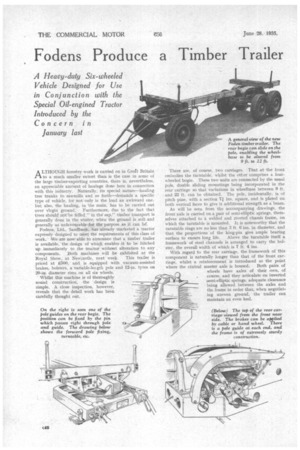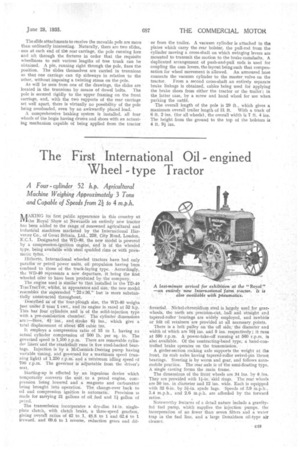Fodens Produce a Timber Trailer
Page 98

Page 99

If you've noticed an error in this article please click here to report it so we can fix it.
A Heaoy-duty Six-wheeled Vehicle Designed for Use in Conjunction with the Special Oil-engined Tractor Introduced by the Concern in January last
ALTHOUGH forestry work is carried on in Gregt Britain to a much smaller extent than is the case in some of the large timber-exporting countries, there is, nevertheless, an appreciable amount of haulage done here in connection with this industry. Naturally, its special nature—hauling tree trunks to sawmills and so forth—demands a specific type of vehicle, for not only is the load an awkward one. but also, the hauling, in the main, has to be carried out over virgin ground. Furthermore, due to the fact that trees should not=be felled "in the' sap;' timber transport is generally done in the winter, when the ground is soft and generally as unfavourable for the purpose as it can be'.
Fodens, Ltd., Sandbach; has already marketed a tractor expressly designed to meet the requirements of this class of work. We are now able to announce that a timber trailer is available, the design of which enables it to be hitched up immediately to the tractor without alteration to any components. Both machineswill be exhibited at the
Royal Show, at Newcastle, next. week. This trailer is priced at am and is equipped with vacuum-assisted brakes, bolsters, a variable-length pole and 12-in. tyres on 20-in, diameter rims. on all six wheels.
Whilst this machine is of thoroughly sound construction, the 'design is simple. A close inspection, however, reveals that the detail work has been carefully thought out. There are, of course, two carriages. That at the front embodies the turntable, whilst the other comprises a fourwheeled bogie. These two units are connected by the usual pole, double sliding mountings being incorporated in the rear carriage so that variations in wheelbase between 9 ft. and 22 ft. can be obtained. The pole, incidentally, is of pitch pine, with a section 72 ins. square, and is plated on both vertical faces to give it additional strength as a 'beam.
As will be seen from the accompanying drawings, the front axle is carried on-a pair of semi-elliptic springs, themselves attached to 'a welded and riveted chassis frame,. on which the turntable is mounted. It is noteworthy that the turntable rings are no less than 3 ft. 6 ins, in diameter, and that the proportions of the king-pin give ample bearing
surface to ensure long life. Above the turntable itself a framework of steel channels is arranged to carry the bolster, the overall width of which is 7 ft. 4 ins.
With regard to the rear carriage, the framework of this component is naturally longer than that of the front carriage, whilst a reinforcement is introduced at the point where the central master axle is housed. Both pairs of wheels have axles of their own, of course, and they articulate on inverted semi-elliptic springs, adequate clearance being allowed between the axles and the frame in order that, when negotiating uneven ground, the trailer can maintain an even keel. The slide attachments to receive the movable pole are more than ordinarily interesting. Naturally, there are two slides, one at each end of the rear carriage, the pole running fore and aft through the fixtures in order that the requisite heelbases to suit various lengths of tree trunk can be obtained. A pin, running right through the pole, fixes the position. The slides themselves are carried in trunnions so that one carriage can tip sideways in relation to the other, without imposing a twisting stress on the pole. As will be seen from one of the drawings, the slides are located in the trunnions by means of dowel bolts. The pole is secured rigidly to the upper framing on the front • carriage, and, with the two supports of the rear carriage set well apart, there is virtually no possibility of the pole being overloaded, even by an awkwardly placed load. A comprehensive braking system is installed, all four wheels of the bogie having drums and shoes with an actuating mechanism capable of being applied from the tractor or from the trailer. A vacuum cylinder is attached to the plates which carry the rear bolster, the pull-rod from the cylinder moving a cross-shaft on which swinging levers are mounted to transmit the motion to the brake camshafts. A duplicated arrangement of push-and-pull rods is used for coupling the cam levers, the layout being such that compensation for wheel movement is allowed. An armoured hose connects the vacuum cylinder to the master valve on the tractor. From a second cross-shaft an entirely separate brake linkage is obtained, cables being used for applying the brake shoes from either the tractor or the trailer; in the latter case, by a screw and hand wheel for use when parking the outfit. The overall length of the pole is 29 ft., which gives a maximum overall trailer length of 31 ft. With a track of 6 ft. 2 ins. (for all wheels), the overall width is 7 ft. 4 ins. The height from the ground to the top of the bolsters is 4 ft. 91 ins.




























































































































































